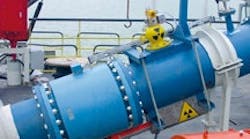For the first time in at least two decades, there’s a new player in gamma nuclear process instrumentation. But Endress+Hauser, according to Level Product Manager Kris Worfe, is no stranger to this technology. “Since 1962,” he says, “we’ve had global experience in multiple industries, with thousands of applications.” Now Endress+Hauser is announcing the U.S. launch of its Gammapilot M nuclear level and density gauges, which the company has sold for decades in other parts of the world.
“The physical principle of this measurement method allows for the precise determination of levels and densities through almost any container material or geometry,” says Worfe. “Since the device is completely noninvasive, it is unaffected by external circumstances like high pressures, high temperatures or problematic corrosive, toxic or abrasive medias.”
The Gammapilot M will measure density, continuous level, interface level and point level, with the only SIL 2/3 certification for gamma point level on the market.
Mass flow in extremely abrasive slurries and in large-sized pipes is possible by connecting an external volumetric flow device, such as the Promag 55S magmeter. The magmeter’s transmitter does the mass flow calculation using the density gauge and flowmeter’s output.
The Gammapilot M uses a scintillation tube as its detector assembly. These devices are made of either PVT or NaI crystal and send to the transmitter a count rate signal that is proportional to amount of radiation received. The deployment of scintillator detectors means that users can continue to use older, more depleted sources rather than disposing of them, since the scintillator can be up to ten times more sensitive than other detector types. This is important because it is not always easy to dispose of used gamma sources.
Another feature of the Gammapilot M is the radiographic testing protection. The FHG60 Modulator will prevent false spikes in measurements due to radiograph testing of process piping or from any other sources of stray radiation. The FHG60 Modulator is connected directly to the Gammapilot M and is synchronized with a motor. This works by rotating stainless steel absorbers at a timed interval. The absorber blocks the radiation from the gamma source at predetermined intervals, thereby allowing the detector to read only background or stray radiation. Then the modulator rotates to the read position, allowing the detector to see the radiation from the source. This enables the Gammapilot M to distinguish the intended radiation from any stray or background radiation.
One of the biggest factors affecting any gamma measurement is ambient temperature. Temperature fluctuations, especially increases, will affect measurement results because the temperature affects the scintillator material and alters its light-gathering abilities. The Gammapilot M dynamically compensates for this by regulating the high voltage of the photomultiplier in the electronics of the Gammapilot M. The influence of the temperature on the pulse rate of the detector is tested in the factory and stored in the device. During operation, the temperature inside the device is constantly measured. Temperature coefficients (device-specific) are used in an algorithm to calculate a compensated pulse rate. The energy spectrum from a radioactive source is constant, so changes in the scintillator’s light-gathering ability are adjusted in relation to the energy spectrum, enabling one of the most accurately temperature-compensated measurement devices on the market today.
Other features include FM, CSA, EX d, Ex e or Ex I current outputs and a 316L housing for heavy-duty applications.
For more information, contact http://www.us.endress.com or call 1-888-ENDRESS.




